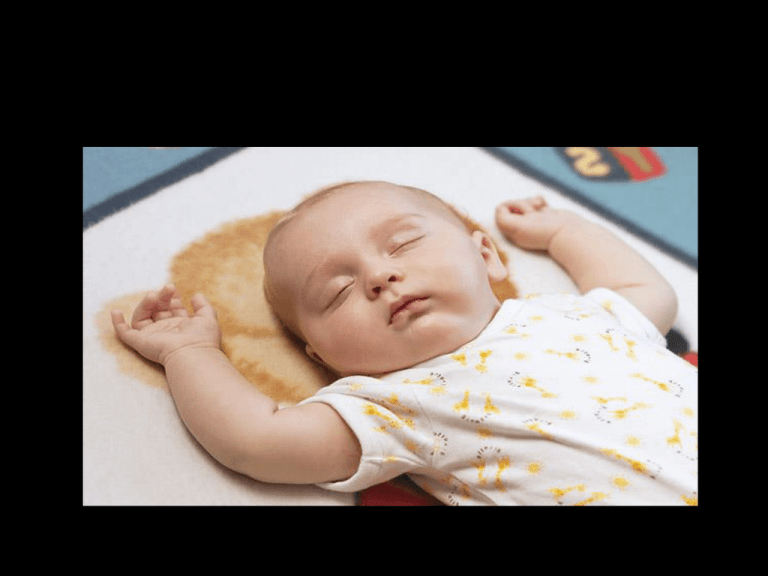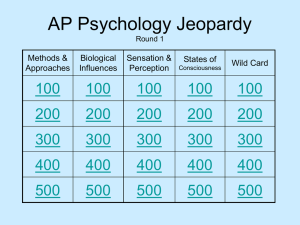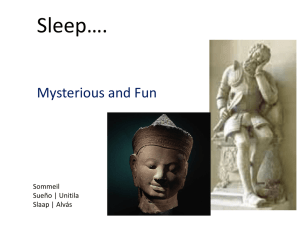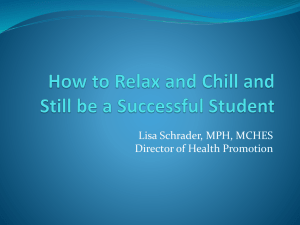
NEUROPHYSIOLOGY OF SLEEP
DR MOHAMMED SUHAIL
Assistant Professor
Department of Physiology
GOALS
• To know types of sleep
• To know different stages of sleep
• To understand how complex neurohumoral
changes occur when we go to sleep .
• To understand sleep disorders.
• DEFINITION:
“ Physiological process by which bodily
functions are periodically rested person
remains unconscious, can be aroused by
sensory or other stimuli”
Physiological changes
• Cardiovascular system:
– Heart rate
– Cardiac output
– Vasomotor tone
– Blood pressure
Decreases
• Respiratory system:
– Tidal volume
– Respiratory rate
– Pulmonary ventilation
Decreases
• BMR:
– decreases by 15%
• Urine volume:
– decreases, phosphate content of urine increases
• Secretions:
– salivary and lacrimal secretion decreases
– sweat secretion increases
– Gastric secretion either remains unchanged or increases
• Muscles :
– completely relaxed , tone decreases
• Eyes :
– pupils constricts
• Blood volume:
– increases due to dilution of plasma
• CNS:
– EEG shows appearance of delta waves
– Superficial reflexes remains unchanged
– Deep reflexes are reduced
– Light reflex is retained
Types of sleep
Neurophysiologist consider two types of sleep
– Non rapid eye movement sleep (NREM)
– Rapid eye movement sleep (REM)
Stages
• Relaxed wakefulness
• Relaxed drowsiness
• NREM
– Stage 1
– Stage 2
– Stage 3
– Stage 4
• REM
Relaxed wakefulness
• Behavioural observation – awake relaxed with
eyes closed
• EEG: mainly Alpha rhythm (8-12 Hz) changes
to alpha block in response to external or
internal stimuli
Relaxed drowsiness
• Behavioural observation:
Fatigue, tired, eyelids narrow and close, head may
start to droop momentary lapse of alertness and
attention –” sleepy but not asleep
• EEG: decrease in alpha amplitude and
frequency
NREM ( slow wave sleep)
• Behavioural observation and EEG changes
Each successive stage have EEG pattern
characterized by slow frequency and high voltage
than previous one
• Significance:
• Pulsatile discharge of Growth hormone and
Gonadotropins from pituitary gland.
• Blood pressure heart rate and respiratory rate
falls ---- metabolic restoration
Stage-1
•
•
•
•
Called light sleep
Easily aroused by external stimuli or neck jerks
Continuous lack of awareness
EEG: alpha wave reduce in frequency and
amplitude
Stage-2
• Called “ true sleep” further lack of sensitivity
to activation and arousal
• EEG:
– characterized by “ sleep spindles”
burst of regular waves of frequency 14 to 15 Hz of
short duration
• Cause: formation of reverberating circuit
between thalamus and cortex
Stage-3
• Sleep further deepens
• EEG: delta waves (1-2 Hz) appear as
background with sleep spindles
Stage-4
• Called “deep sleep”
• Slow high voltage delta waves
REM( paradoxical sleep)
• EEG: resembles that of awake alert person
rapid low voltage irregular waves
( Desynchronised pattern of EEG)
• Behavioural observation:
Deepest sleep, greatest muscular relaxation and
fall in the muscle tone
• Extremely difficult to arouse the person
• Saccadic eye movements from one fixation
point to other- sweeping search of objects in
the dreams
• Snoring- tongue fall
• Dreaming
• Blood pressure heart rate and respiration
becomes irregular
• Bruxism, erection of penis ejaculation may
occur.
• Associated with large biphasic potential in
group of 3-5
• Originate in the pons pass to LGB ultimately
terminate in occipital cortex hence called PGO
spikes
• PGO spikes activate bulboreticular inhibitory
area leading to marked hypotonia
AWAKE
NREM
REM
Sleep cycle
• Each cycle consist of NREM and REM
• Average total sleep period comprises of 4 to 5
such cycles
• Each cycle repeats after 90 min
– NREM- 80%
– REM- 20%
• REM time increases towards morning
• In full-term neonates REM Constitutes 50% of
total sleep time.
• in Premature infants REM sleep occupies 80%
of total sleep time.
Genesis of sleep
• Genesis of NREM
• Previously thought: fatigue of reticular
activating system but was found false
• But Sleep is an active phenomenon
• Synchronous activity in the brain is must for
person to fall asleep
• NREM Sleep is produced by two important
factors
– Inhibition of reticular activating system by
descending pathways from preoptic area
and diagonal band of broca this prevents
desynchronisation
– Stimulation of sleep promoting
mechanism:
rhythmic discharge of impulses from
thalamus “ synchronization mechanism”
– synchronising mechanism is influenced by
• Diencephalic sleep zone in hypothalamus
and intralaminar and anterior thalamic
nuclei
• Medullary synchronising zone in reticular
formation of medulla
• Regular repeated monotonus stimuli put the
children to sleep
• Genesis of REM
– Discharge of Nor-epinephrine from neurons
located in pontine Reticular formation and
locus cerulus
PGO spikes are due to discharge of cholinergic
neurons
Control of sleep waking cycle
• There are two important mechanisms
– Neural mechanism
– Humoral mechanism or chemical mechanism
• Neural mechanism:
– Sleep and wakefulness alternate about once a day they
manifest a circadian rhythm consisting of 8 hrs sleep and
16 hrs awake state.
– basic rhythm is controlled by biological clock function of
hypothalamic suprachiasmatic nucleus and pineal gland
• Sleep waking cycle involves
arousal system
and sleep producing system
• Mechanism producing arousal
– Stimulation of sensory system
– Stimulation of midline Reticular formation
– Stimulation of raphe nuclei
• Mechanism that activate sleep producing system
– Removal of afferent stimuli l/t deceased activity of
Reticular
– Stimulation of anterior and dorsal hypothalamic area
• Humoral or chemical mechanism:
– Neurotransmitters involved in sleep
serotonin
nor-epinephrine
acetyl choline
hypotoxin
delta sleep inducing peptide
sleep promoting factor ( factor S)
• Transition from sleep to wakefulness involves
alternating reciprocal activity of different
group of RAS neurons
• The diurnal change in melatonin secretion
from serotonin in the pineal gland functions as
a timing signal to coordinate events with the
light–dark cycle, including the sleep–wake
cycle.
Sleep Disorders
• Insomnia:
“repeated difficulty with sleep initiation,
maintenance, consolidation, or quality that occurs
despite adequate time and opportunity for sleep
and that results in some form of daytime
impairment.”
Narcolepsy:
• It’s a tetrad of
– Excessive day time sleepiness
– Cataplexy
– Hypnogogic hallucination
– Sleep paralysis
Excessive day time sleepiness is primary symptom
EDS may occur at the time of driving, eating, talking
• Patient falls asleep without warning
• Cataplexy : triggered by emotions (laughter
anger) head nod and buckling of knee occur
• Sleep paralysis
• Obstructive sleep apnea (OSA)
• Sleepwalking(somnambulism)
Summary
• principal value of sleep is to restore natural
balances among the neuronal centers.
• The entrainment of biological processes to the
light–dark cycle is regulated by the SCN.
• The diurnal change in melatonin secretion from
serotonin in the pineal gland functions as a
timing signal to coordinate events with the light–
dark cycle, including the sleep–wake cycle.
THANKS





